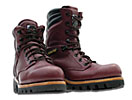
Anyone who has ever stubbed a toe in the dark, had a flip-flop blow out, walked barefoot across gravel or otherwise tempted foot fate knows how tender the toes and soles can be once bruised, scraped, cut or bashed. Few, if any, can argue the importance of proper footwear (and those who claim ignorance are those who will suffer greatest in the dark, at the mercy of the chair leg).
OSHA covers this consideration in 29 CFR 1910.136 (General Industry) thusly:
- General requirements. The employer shall ensure that each affected employee uses protective footwear when working in areas where there is a danger of foot injuries due to falling or rolling objects, or objects piercing the sole, and where such employee’s feet are exposed to electrical hazards.
- Criteria for protective footwear.
- Protective footwear purchased after July 5, 1994 shall comply with ANSI Z41-1991, "American National Standard for Personal Protection-Protective Footwear," which is incorporated by reference as specified in Sec. 1910.6, or shall be demonstrated by the employer to be equally effective.
- Protective footwear purchased before July 5, 1994 shall comply with the ANSI standard "USA Standard for Men’s Safety-Toe Footwear," Z41.1-1967, which is incorporated by reference as specified in Sec. 1910.6, or shall be demonstrated by the employer to be equally effective.
Identify your needs
So much for any help there. But look back at 1910.136 (a). That’s right, OSHA can be of some help after all in spelling out hazards to identify:- falling or rolling objects — hazards that might overrun the top of the foot and crush or bruise it;
- objects piercing the sole — sharps that would puncture or cut the sole of the foot;
- and where exposed to electrical hazards — where stepping or brushing against live electrical parts might expose one to shock hazards.
"The employer shall assess the workplace to determine if hazards are present, or are likely to be present, which necessitate the use of personal protective equipment (PPE). If such hazards are present, or likely to be present, the employer shall: (i) Select, and have each affected employee use, the types of PPE that will protect the affected employee from the hazards identified in the hazard assessment; (ii) Communicate selection decisions to each affected employee; and, (iii) Select PPE that properly fits each affected employee."
Non-mandatory Compliance Guidelines for Hazard Assessment and Personal Protective Equipment Selection is located in Appendix B of that section. To make a long appendix short, primary considerations for assessing foot hazards can be fleshed out during a walk-through survey of your workplace. Some useful information within Appendix B includes:
"Safety shoes or boots with impact protection would be required for carrying or handling materials such as packages, objects, parts or heavy tools, which could be dropped; and, for other activities where objects might fall onto the feet.
"Safety shoes or boots with compression protection would be required for work activities involving skid trucks (manual material handling carts) around bulk rolls (such as paper rolls) and around heavy pipes, all of which could potentially roll over an employee’s feet."
Here’s another note (mine, not OSHA’s): You must also consider the potential for injury to the top of the foot, not just the toes, and determine if metatarsal guards in addition to hard-toes is prudent.
Program example
Our minimum requirements and shoe/boot program is arranged in the following way: Composite-Toe Work Boot/Shoe ($150.00 maximum payment by company. If this amount is exceeded, the employee will be responsible for the difference in price.)Eligible Employees: Electronics Technicians, Electronics Technician II, Electro-Mechanical Technicians, Mechanical Technicians, Custodians, Stores, Operations Servicepersons.
Soft-Toe Work Boot/Shoe ($100.00 maximum payment by company. If this amount is exceeded, the employee will be responsible for the difference in price.)